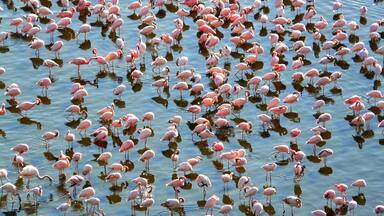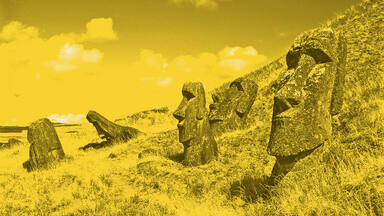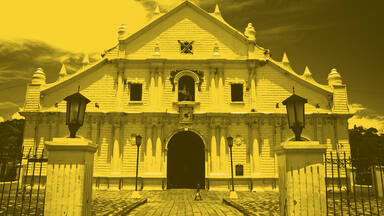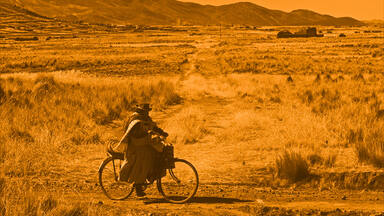This guide 10 will tell you why benchmarking matters and suggest some ideas on how you can develop site and destination specific benchmarks.
Steps to success
Why this matters
MoreThere are a number of reasons why monitoring is important for World Heritage sites:
- To ensure that the OUV (Outstanding Universal Value) of a site is being maintained
- To assess the condition and/or state of conservation
- To allow outstanding issues to be recognised and dealt with
- To allow good practice, knowledge, and experiences to be shared between states, site managers, and other heritage professionals.
However – as Guide 1 (Understanding tourism at your destination) and Guide 2 (Developing a strategy for progressive change) stressed – it also very important to ensure that, at a destination scale, the product and experiences being offered to visitors are of the right quality and nature, as well as securing the return they deserve. There should also be benchmarks of key issues and the monitoring of their impacts on the host community.
Another key reason monitoring is crucial is to capture the effectiveness of different measures in a way funders and investors can see evidence their investment has made a difference, and to provide you with important information to persuade future investors that ‘$X amount of investment can deliver Y number of outcomes’.
Lastly, the credibility and buy-in for sustainability depends to an extent on the outcomes being transparent, accountable, and evidence-based. If you want the wider destination to support sustainability, then you need to build the evidence base for it, and encourage people to question and challenge your approaches.
When you undertake your initial analysis and develop your strategy, you need to identify sensible benchmarks and milestones
MoreBelow are some of the important benchmarks you should consider:
1) Conservation or environmental benchmarks
The primary benchmarks should be about protecting the World Heritage site's OUV. While many stakeholder aspirations will be economic, the key responsibility and obligation for managers of World Heritage sites and the State Parties is to protect and preserve the values of the site. Nothing should compromise this. There is no simple blueprint for what these benchmarks should be, each site will have a unique cultural or natural set of attributes and these must be captured in a site-specific set of benchmarks. For example, a natural site may want to manage the risk of invasive species or the threat of poaching, whereas a cultural site may wish to prevent damage to monuments from traffic. The evidence used to analyse benchmarks should be replicated at every site to provide a comparison at different moments in time – are things getting better, staying the same, or getting worse?
2) Community benchmarks
The second set of benchmarks should be about monitoring the positive and negative impacts on the host community. A key element of sustainability is providing host communities with a powerful voice in how tourism affects them. Often the impacts – both good and bad – on local people are accepted as a kind of collateral damage created by tourism, something inevitable and unavoidable. However, this certainly should not be the case. Sustainable tourism must monitor these impacts and take them very seriously. There is no perfect way to do this, and different societies and cultures will have different preferences or models for achieving it. However, the key principle is the host community is part of the process of understanding tourism, (Guide 1, Understanding tourism at your destination), formulating strategy (Guide 2, Developing a strategy for progressive change), and setting the benchmarks to evaluate whether or not the destination is providing them with what they need and aspirations they have outlined.
Some destinations might monitor:
- The average wage in the tourism sector paid to local people
- The poverty rate in the local community
- The quality of life of the host community
- The percentage of young people finishing school
- The percentage of local young people who receive training in the tourism industry
- Even the number of local people who run a business.
Other benchmarks might be about when the destination feels too crowded or when quality of life deteriorates because of congestion – such measures are subjective, but can be measured if people are encouraged to keep simple records or diaries. The number of potential benchmarks is endless, but you can work with the community to determine the ones that matter to them.
3) Economic/Tourism benchmarks
The previous two sets of benchmarks were about protecting places and protecting communities, but it is, of course, necessary to benchmark a number of key tourism variables. These will differ from site to site, but as we saw in Guide 1 (Understanding tourism at your destination), it is crucial to understand the specific tourism trends for the destination in a way site and destination managers are aware of how many people are visiting, when they are coming, why they are coming, how much they are spending, and in what ways. There is a need for benchmarks that shed light on both the demand and supply side of the tourism sector.
Unfortunately, many sites do not monitor visitor expectations and perceptions about the quality of what they experience – this is crucial. In this guide, we stress that many more sites need to develop simple surveying techniques to provide insights for monitoring this over time. All significant tourism destinations should also be monitoring the economic value of tourism to the local area, as this is a key benchmark and crucial to understanding and communicating its significance.
4) Other benchmarks
The strategic focus of different sites will inform which benchmarks should be monitored over time. Be confident in making the benchmarks fit-for-purpose for your site and its context. Do not worry if your benchmarks are unique to your site – they should be. If the key local issue is visitor management, then most benchmarks may be about that issue. Similarly, if the issue is an unsustainable funding situation, then the benchmarks might be about costs relative to income. Your issue might also be ecological degradation, so the benchmarks might be about the quality of the environment. All of these are site-specific, and all must be based on understanding the issues and challenges of the site as set out in Guide 1 and 2.
Benchmarks should be SMART
MoreSpecific. Be extremely clear about what you mean; vague or generic benchmarks do not work – target a specific area for improvement.
Measurable. Benchmarks must be based on data that can be repeated to provide comparisons – this requires quantifiable measures.
Assignable. Things only happen if someone is tasked with doing them, specify in your strategy who will make this thing happen.
Realistic. State what can realistically be achieved in the given time period, considering available resources.
Time-related. Specify when the action will be undertaken, and when its outcome can be achieved.
Benchmarks and results should be published and signed by the key stakeholders as transparent measures of success or failure
MoreBenchmarks should be relatively simple to understand and should be widely communicated. We recommend no more than 10 benchmarks, which should be published as the final page of the strategy (See Guide 2, Developing a strategy for progressive change). Tourism businesses can struggle to understand heritage professionals at times, so having a simple set of benchmarks that can be explained easily to everyone is important.
Identify funders and investors who might be interested in similar outcomes
MoreSome of the following sources should be considered for funding (and others specific to your site!):
1) Governments and statutory bodies
In many sites there will be a relatively sustainable funding situation with the State Party or relevant bodies taking full responsibility for the costs of conserving, interpreting, and enhancing the site and the wider destination. Sadly, this will not always provide sufficient funding for the implementation of the strategy, so other sources of funding/investment may be necessary. World Heritage sites are global entities, so do not confine your analysis to local or national boundaries. Sometimes help is available through transnational funding, such as the EU, World Bank, or other State Parties with a particular interest in your kind of site or activities. For example, much of the funding for the Valley of the Kings in Egypt has come from Japan, so think more broadly about which governments and government agencies might be able to help.
2) Third sector charities, trusts, and foundations
In many societies around the world there are philanthropic trusts, charities, and organizations that have funds to invest in projects that meet their objectives. Having a basic understanding of these is important, as it may give you opportunities for investment. Again, think globally because many fundraising mechanisms are now global. Identify possible third sector donors and investors and think about what outcomes they will require for their investment – read their websites and funding guidance.
3) Corporate sponsorship
As a World Heritage site you are of significance to the whole world, and many responsible and philanthropic companies will value association with your site. Some businesses may wish to secure the benefits of public relations (PR) of being seen as investors in the preservation of the site or be involved in a specific project. However, be cautious about donors’ motivations and set clear ground rules and expectations about what is and is not appropriate. Start to make a list of companies with a link to the site, or which might be approached for other reasons to secure investment.
4) High net-worth individuals
Many people who have had the good fortune to become affluent are looking for ways to leave a lasting legacy, and there is no greater lasting legacy than to help preserve a World Heritage site for future generations. For this to happen, sites need to be able to present their needs, their projects, and the chance to invest in a structured manner. Think about where these individuals are, and how you can get their attention with a well-thought out pitch that will appeal to their philanthropy. When selecting individuals it is particularly important to be aware of their personal interests and values, and to craft individual-specific pitches.
5) Residents
Sometimes a great source of funding and investment lies right within the site – in the form of the local communities. Having a local community membership/donor scheme that encourages the involvement of local people in the preservation of the site can be a powerful tool. It becomes about more than the money. Sometimes people who have left the local community to go and work elsewhere are affluent and looking for ways to return benefit to the host community or the heritage of the site/destination. This can be made possible with new technologies and ideas like payroll giving or requests for donations for special initiatives. Think about how such a scheme might work and the ways that it could become a reality. For instance, would people enter a lottery each week in aid of the site? Is that appropriate to your society? If not, think of other ways to encourage them to contribute willingly.
6) Tourism organizations and businesses
The investment required will often be commercial investment in the tourism infrastructure rather than philanthropic contributions for conservation. However, this investment is also critical – remember, a crucial part of the discussion concerns what types of development and infrastructure are appropriate for the site and its values.
As we saw in Guide 6, Managing the development of tourism infrastructure, it is essential to set the limits and constraints on growth so developers and businesses understand what is and is not appropriate at a World Heritage site. In some states, there are legal mechanisms to return a share of the gain from new developments to conservation and local socio-economic development initiatives. Tourism businesses are often looking to establish schemes that let them achieve social, cultural, or environmental outcomes as a means to give something back, or raise their profile and perception they are a responsible business with good ethics.
There is a temptation to overestimate tourism businesses as an easy source of funding. In reality, many tourism businesses are small and only marginally profitable. Think about how you can transform tourism businesses into fundraisers, donors, or champions of the site. Think about how you can reach out to the tourism businesses and encourage them to develop more sustainable infrastructure or raise funds for conservation. Many businesses are quite willing to do this because it makes them look good to consumers, and other businesses will quickly follow suit when they see that it works.
7) Visitors
A growing number of destinations around the world are developing systems to encourage direct financial contributions from visitors to sustain the heritage at the heart of the destination, or for local socio-economic development. In some societies and cultures, the preference is for a mandatory tax imposed on visitors at the entry point, on the ticket price, or on beds in the accommodation sector. In other cultures, the preference is for voluntary contributions from visitors through communicating the site's needs and making it easy to donate during the holiday experience.
8) Citizens of the world
The rise of internet-based crowdsourcing models means that sites can, and should, reach out to an interested and sympathetic audience around the world. You can establish a relationship with them that makes them participants in the life of the site, as well as potential donors for social initiatives. The platforms already exist to do this, but very few sites have developed suitable projects and projected them into the world for donations.
Who does the monitoring?
MoreGuide 1 (Understanding Tourism) outlined that data on the conservation status of the site; the needs, aspirations, and quality of life of the host community; and the performance of the tourism sector, will be held by a range of stakeholders. Therefore, benchmark evidence will have to be monitored in the same way – by working together with a range of partners and providing the evidence through which benchmark performance can be assessed. When setting the strategy and agreeing on responsibilities for actions/activities (Guide 2, Developing a strategy for progressive change), you should ensure that stakeholders commit to their part of gathering data and periodically reporting progress against the agreed benchmarks.
Assess what is working and what is not; if you need to do things differently, then refresh your strategy
MoreThe whole point of a strategy and benchmarks is to provide a measure of what is and what is not working. It is crucial that you commit to reviewing progress and analysing the evidence at appropriate intervals. Ask yourself truthfully whether or not the actions/activities implemented are having the desired impact on the issues. If they are, congratulate yourself on the success, refocus on the remaining issues, or identify new ones. If your benchmarks are revealing a decline in circumstances, then you need to be honest and reassess what is needed.
It may be that you change your strategy in the light of what you learn from your successes and failures. Some of the most progressive World Heritage sites are those that have made lots of mistakes and quickly learned how to do things better. No one has all the answers to your site-specific problems, so there will be a degree of trial and error to your solutions. Do not worry about failure, it means you are trying to make a difference. By monitoring and benchmarking, you can quickly assess and learn from your failures to succeed next time.
Saving the world is not easy; it is not a race with an end point
MoreCelebrate and publicize your successes. When you do great things and solve strategic issues, be sure to tell everyone in the destination and beyond about it. Asking people, communities, and businesses to work with you over a period of time requires faith in you and your actions/activities. If you forget to tell people when you achieve something, it will go unnoticed, and their faith in you will be weaker as a result.
Go back to the start, and look again at tourism in your destination and World Heritage site. Look at what the issues are, what the pressures are, and how you are performing compared to other World Heritage destinations. Things change fast in tourism (not the least of which are visitors’ expectations of quality and storytelling), and new technologies mean that nothing stands still. Start the strategic process again – make your destination the most sustainable and most effective place it can possible be. Also, If you have cracked all the issues, please tell us about it… few sites have.









